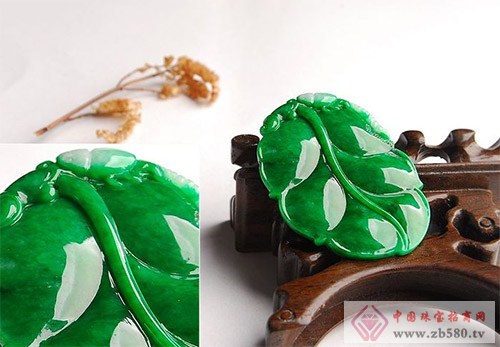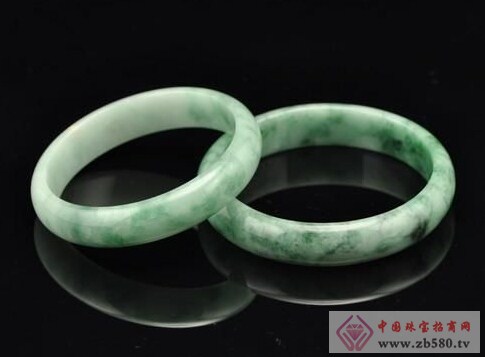When it comes to the topic of the difference between jade a cargo and b cargo, everyone must know a little bit. Today, Xiaobian introduces the difference between jadeite and b-goods in many aspects: jadeite A is jadeite that has not been chemically treated, and B-car jadeite is jadeite that has been pickled. There is a certain commonality between the two. There are also many differences.

Common features of Jade A and B goods
Jadeite is a mineral aggregate composed of a variety of fine minerals, mainly jadeite. Its main mineral is jadeite, which can contain many minerals such as hornblende and albite. The jadeite is naturally mined, and the jadeite A goods are not treated by any industrial method; after pickling, the epoxy resin is filled with jadeite B. The main minerals of Jadeite A and B are mainly jadeite, the structure is basically similar, and the colors are all natural colors. Only the B goods wash away the black and brown impurities in the substrate during the pickling process.
Characteristics of Jade A goods: (relative to the difference between B goods)
The main component of jadeite is jadeite, which has a chemical composition of NaAlSi2O6 and may contain a small amount of Ca, Mg, iron, Cr, Mn, Ti, S, Cl, and the like. In the natural formation process of jade, there is more or less the presence of iron ions. The jadeite A goods are observed by transmitted light, and the colorless part of the base is slightly yellowed. The industry calls it "yellow water" and whether "yellow water" exists. It is an important identification feature of Jade A and other processed products. The color of the jadeite A product has a color root, the color is tangible, and the distribution is uneven. The green part has a distribution from the inside to the outside and transitions from shallow to deep. The green part has no divergence and the dot color has no diffusion. Under the UV lamp, the Jadeite A product has no fluorescence.
The surface characteristics of the jadeite A cargo are as follows: the high-grade jade texture will have a water-like (orange effect) surface, and the polished jade will have sporadic small pits. Different from the "ditch" formed by the cleft palate formed by the acid etching of the surface of the B cargo, the boundary between the agglomerate and the depression of the A cargo is gradually smooth transition, and the boundary of the B jade is separated by the acid etching. Intuitive observation shows that when the particles are similar, the natural jade has a bright luster, the surface is smooth and round, and the surface of the B and the covered jade is rough and the gloss is not strong.
The internal characteristics are observed by transmitted light, the transparency of the natural jadeite is uneven, the transparent part is clear and transparent, and the boundary with the opaque part is distinct, and there are brown and black impurities inside. The base of the B goods is unclear, there is no clear and transparent part, and there are no brown or black impurities.

Characteristics of jade B goods: (relative to the difference between A goods)
B goods dissolve the variegated and dirty colors in the jade in the pickling, and also dissolve some of the jadeite particles, destroying the dense structure of the jadeite, so there are more large gaps between the particles. It is even loosely crumb-like, so it must be filled with some organic polymer (such as resin or plastic) that can be consolidated, that is, the emerald is consolidated and the transparency is enhanced. Therefore, we can separate from the A cargo from the following aspects.
1. Color characteristics: Although the green color of the jade treated by this method is still the original color, after the soaking with the acidic solution, the base becomes white, the green also becomes yellow, looks very unnatural, and the green distribution is relatively floating (no The color root), the original silky, ribbon-like color is gradually expanded, and the original color orientation is also destroyed. Because of the precipitation of iron ions, the colorless base portion is grayish white, and no "yellow water" appears. Under the UV lamp, the B-car jade has obvious fluorescence.
2, surface characteristics: Because the hardness of the filling itself and the hardness of the jade itself are different, so the surface is prone to "cobweb effect", that is, the surface is uneven, in the original cleft, the obvious groove, the filling is obviously low On both sides, many clefts form a "ditch" that criss-crosses. Under the condition that the sensory looks at the past and the color is very delicate, the surface gloss is darker than the A-like product of similar color.
3. Magnification inspection: Observing the internal structure of the particles requires the use of transmitted light. The B-carved jade structure after bleaching and filling treatment is loose, the boundary of the particles is blurred, the particles are broken, the cleavage is discontinuous, and the emerald becomes weak or disappears. And the overall whitening, the base is turbid, foggy, transparent (planting water) is basically the same everywhere, the overall seeding water becomes single, there is no transparency to translucency.
4, tapping: A goods sound like metal is crisp and pleasing, B goods sound dull, this method is limited to bracelets.
5, instrument identification: using Fourier infrared absorption spectrometer identification, in the infrared spectrum, Jade B goods in the vicinity of 3050 wave number has epoxy resin absorption peak, while Jade A goods have no absorption peak. This method is the main method of identification of jewelry appraisal institutions at home and abroad.

Emerald A and B price area
In general, the certificate issued by each institution should be credible, because the large number of applications of infrared spectrometers make the Jade A and B goods identification simple operations, generally no mistakes. The identification certificate of Jadeite A will be marked with "Jade", "Jade (A)" or "Jade Pendant", etc., while Jade B will be marked with "Jade (handling)" and marked "bleach filling" in the remarks. Handle "or" bleaching and filling treatment of jade." Jade B has been hand-treated. Wearing it for a period of time (usually 2-5 years) will lose its luster due to the aging of the filled epoxy resin, and it will turn yellow, white, and brittle, and will not have the value of quality. However, due to its low price and strong decoration, it can be worn as a general ornament.
With the price of jade rising all the way, the price of A goods has risen very rapidly. Now the price of a jade bracelet on the market is tens of thousands of yuan, some even a few million yuan, and the jade bracelet of several thousand yuan is not the appearance. well. The price of B-bundle bracelets is generally around a few hundred yuan, and the similar appearance of A and B bracelets, the price difference is a hundred times. Of course, the Jadeite A goods are also divided into high, medium and low grades. The price ranges from tens of yuan to several million yuan. Some A, non-colored, granules and large granules are also very cheap.
The difference between the wearing of Emerald A and B goods
The high price of jade is beyond the reach of many ordinary consumers. Jade B goods meet the needs of some people. Jade B products are used as a substitute for jade A goods on certain occasions. There is still a certain demand in the market. Consumers who don't want to spend too much money on jadeite can choose Jade B goods as decorative items to meet consumer demand. Because the jadeite B has been manually processed, the durability is affected and cannot be preserved for a long time. It can only be worn as a general ornament. Wear jade B goods need to pay attention to wear, bathing, sun exposure, exposure to chemical reagents, high temperature will accelerate the aging rate of resin in B goods, so try to avoid the above situation.
Jadeite A has not been treated by any industrial method. It can guarantee that the appearance will not change greatly after being worn for several decades or hundreds of years. It can be preserved as a treasure of the family and can be used as one of the value-preserving investment choices; The reason is that wearing various shapes of jade can satisfy people's psychological needs such as avoiding disasters and blessings, and changing wealth and wealth, making jade a popular product in the Chinese jewelry industry. High-grade jade A goods are expensive, and you must be very careful when wearing jade jewelry, pay attention to the maintenance of jade bracelets. Try to avoid dropping it from a height or hitting a hard object, especially jade jewelry with a small amount of cracks. Otherwise it is easy to break or damage. If it is exposed to oil for a long time, the oil will stick to the surface and affect the brilliance. Sometimes dirty oily grease fills along the cracks of jade jewelry, which is unsightly. Therefore, in order to keep the jade jewelry clean, it is often washed with a soft cloth in a neutral detergent, dried and then polished with a silk cloth. After the jade jewelry is carved, it is often waxed to increase its glamor. Therefore, jade jewelry cannot be in contact with acids, alkalis and organic solvents. When the jade is taken down for storage, it should be placed separately in the jewelry box. Never put together with harder gems (such as diamonds, rubies, sapphires, etc.), because those with too much hardness may scratch the surface of the jade.
Regarding the difference between jade a cargo and b cargo, the above introduces you through the comparison method. Of course, it is not very comprehensive. Xiaobian hopes that through the above introduction, everyone can grasp the difference between jade a cargo and b cargo.
Cationic Polyester Fabric,Cation Jersey,Cationic Polyester Jersey Fabric,Cationic Jersey Fabric
Zhejiang Tangber Trade Co .,Ltd , https://www.tangber.com
